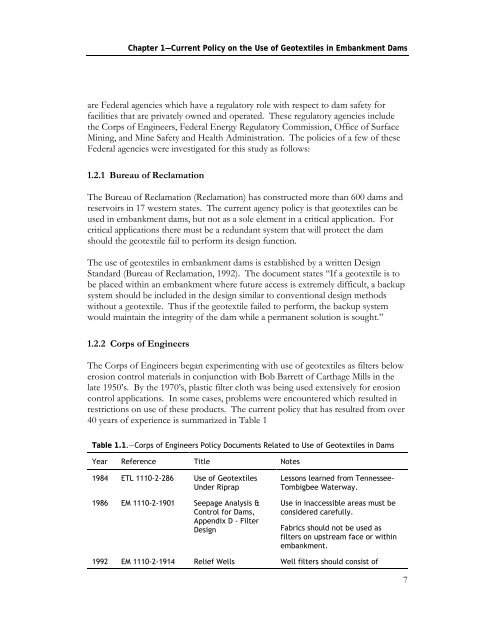Geotextiles in Embankment Dams - Association of State Dam Safety ...
Geotextiles in Embankment Dams - Association of State Dam Safety ...
Geotextiles in Embankment Dams - Association of State Dam Safety ...
Create successful ePaper yourself
Turn your PDF publications into a flip-book with our unique Google optimized e-Paper software.
Chapter 1—Current Policy on the Use <strong>of</strong> <strong>Geotextiles</strong> <strong>in</strong> <strong>Embankment</strong> <strong><strong>Dam</strong>s</strong>are Federal agencies which have a regulatory role with respect to dam safety forfacilities that are privately owned and operated. These regulatory agencies <strong>in</strong>cludethe Corps <strong>of</strong> Eng<strong>in</strong>eers, Federal Energy Regulatory Commission, Office <strong>of</strong> SurfaceM<strong>in</strong><strong>in</strong>g, and M<strong>in</strong>e <strong>Safety</strong> and Health Adm<strong>in</strong>istration. The policies <strong>of</strong> a few <strong>of</strong> theseFederal agencies were <strong>in</strong>vestigated for this study as follows:1.2.1 Bureau <strong>of</strong> ReclamationThe Bureau <strong>of</strong> Reclamation (Reclamation) has constructed more than 600 dams andreservoirs <strong>in</strong> 17 western states. The current agency policy is that geotextiles can beused <strong>in</strong> embankment dams, but not as a sole element <strong>in</strong> a critical application. Forcritical applications there must be a redundant system that will protect the damshould the geotextile fail to perform its design function.The use <strong>of</strong> geotextiles <strong>in</strong> embankment dams is established by a written DesignStandard (Bureau <strong>of</strong> Reclamation, 1992). The document states “If a geotextile is tobe placed with<strong>in</strong> an embankment where future access is extremely difficult, a backupsystem should be <strong>in</strong>cluded <strong>in</strong> the design similar to conventional design methodswithout a geotextile. Thus if the geotextile failed to perform, the backup systemwould ma<strong>in</strong>ta<strong>in</strong> the <strong>in</strong>tegrity <strong>of</strong> the dam while a permanent solution is sought.”1.2.2 Corps <strong>of</strong> Eng<strong>in</strong>eersThe Corps <strong>of</strong> Eng<strong>in</strong>eers began experiment<strong>in</strong>g with use <strong>of</strong> geotextiles as filters belowerosion control materials <strong>in</strong> conjunction with Bob Barrett <strong>of</strong> Carthage Mills <strong>in</strong> thelate 1950’s. By the 1970’s, plastic filter cloth was be<strong>in</strong>g used extensively for erosioncontrol applications. In some cases, problems were encountered which resulted <strong>in</strong>restrictions on use <strong>of</strong> these products. The current policy that has resulted from over40 years <strong>of</strong> experience is summarized <strong>in</strong> Table 1Table 1.1.—Corps <strong>of</strong> Eng<strong>in</strong>eers Policy Documents Related to Use <strong>of</strong> <strong>Geotextiles</strong> <strong>in</strong> <strong><strong>Dam</strong>s</strong>Year Reference Title Notes1984 ETL 1110-2-286 Use <strong>of</strong> <strong>Geotextiles</strong>Under Riprap1986 EM 1110-2-1901 Seepage Analysis &Control for <strong><strong>Dam</strong>s</strong>,Appendix D - FilterDesignLessons learned from Tennessee-Tombigbee Waterway.Use <strong>in</strong> <strong>in</strong>accessible areas must beconsidered carefully.Fabrics should not be used asfilters on upstream face or with<strong>in</strong>embankment.1992 EM 1110-2-1914 Relief Wells Well filters should consist <strong>of</strong>7
















